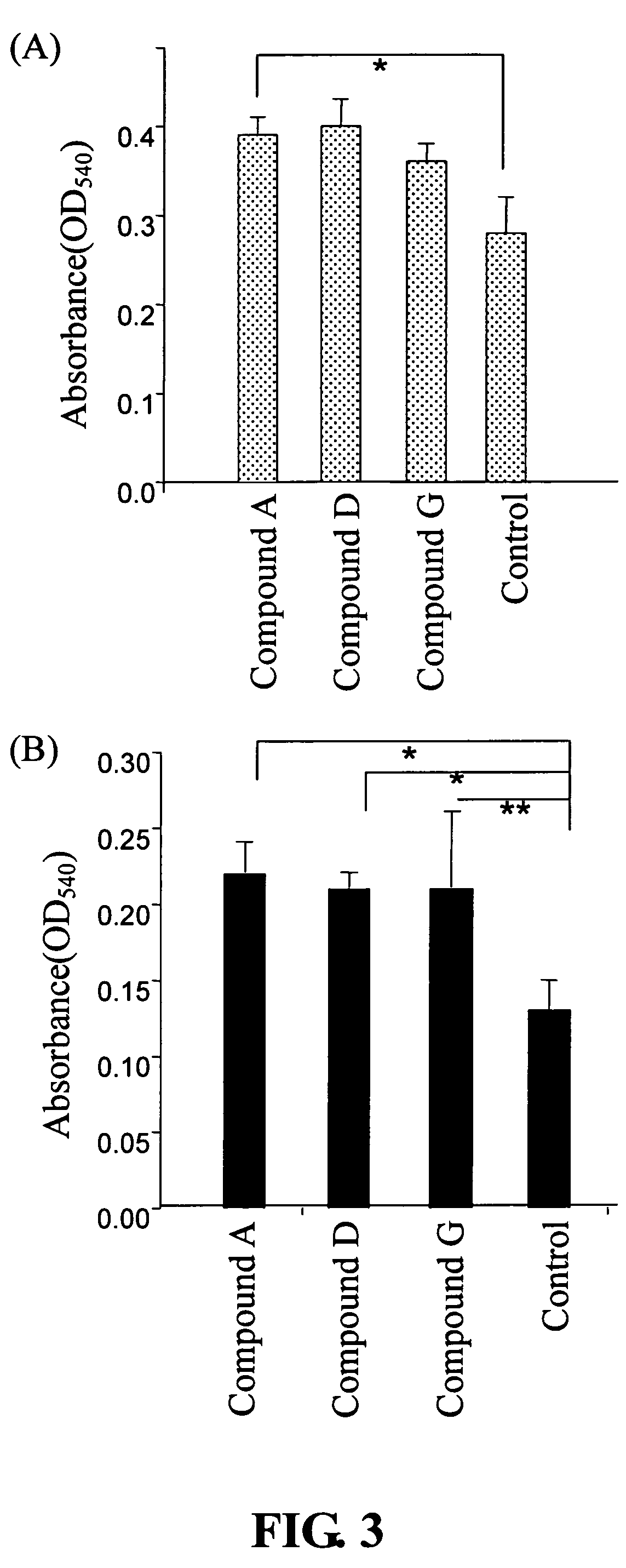Compound for promoting the growth of neural cells
a neural stem cell and growth factor technology, applied in the direction of biocide, peptide/protein ingredient, peptide source, etc., can solve the problems of limited clinical applications of these drugs, and achieve the effects of increasing the survival rate of neural cells, promoting the growth of cortical neurons, and small siz
- Summary
- Abstract
- Description
- Claims
- Application Information
AI Technical Summary
Benefits of technology
Problems solved by technology
Method used
Image
Examples
example 1
[0047]The growth medium for NSCs was prepared by adding penicillin G, streptomycin sulphate and 0.5 mM of L-glutamine into B-27 supplemented neurobasal medium (Gibco).
[0048]The unborn fetus was taken out from fetal sac in the abdominal cavity of a 16-day pregnant Wistar rat under anesthesia. The cerebral tissue was removed from the fetus and treated with 0.1% trypsin solution for one minute at 25° C. After washing with PBS solution 3 times, cells were dissociated by the known mechanical method of up and down mixing. The resulting solution was passed through a 70 μm Nylon cell strainer (Falcon) in order to obtain the cerebral cells in the filtrate. The filtrate was centrifuged at 1000 rpm for 10 minutes and the supernatant was aspirated and the pellet re-suspended in the growth medium prepared above. The resulting suspension of the obtained cells contained NSCs.
[0049]The cells in the suspension were seeded at around 150,000 cells / ml onto 10-cm Petri dishes (10 ml was used). The cells...
example 2
[0052]Cells obtained from the suspension prepared in Example 1 were cultivated in 6-well plates coated with 30 μg / ml of poly-D-lysine (Sigma) at 300 cells / mm2 and cultivated at 37° C., 5% CO2 and 95% relative humidity. The growth media contained compounds A, B, D, E, F, G, and H respectively and the growth media added with 5 μl of DMSO were used as control. The differentiated cells after cultivation were categorically called cortical neurons.
[0053]The experiments were repeated three times. After cultivating for 5 days, live cells were counted by a known cell-counting method (MTT assay) and the absorbance was read at 540 nm. The results are shown in FIG. 2.
[0054]The results from FIG. 2 show that the absorbances of the experimental group are significantly higher than those of the control group; the best results are found with compound A, D, and G. The results show that the compounds of the invention increase the survival rate of cortical neurons significantly.
example 3
[0055]Cells obtained from the suspension prepared in Example 1 were cultivated at a density of 150 or 300 cells / mm2 in 6-well plates coated with 30 μg / ml poly-D-lysine (Sigma) at 37° C., 5% CO2 and 95% relative humidity. The growth media contained compounds A, D, and G respectively and the growth media added with 5 μl of DMSO were used as control. The differentiated cells are categorically called cortical neurons.
[0056]The experiments were repeated three times. After cultivating for 5 days, the live cells were counted by a known cell-counting method (MTT assay) and the absorbance was read at 540 nm. The results are shown in FIG. 3.
[0057]It has been known that the survival rate of cortical neurons cultivated at a cell density of 640 cells / mm2 can be as high as greater than 90%; while cultivated at a cell density of 160 cells / mm2 the survival rate drops down to around 50%. Therefore without adding any growth factor at proper time when cells are cultivated at less than 160 cells / mm2 th...
PUM
| Property | Measurement | Unit |
|---|---|---|
| time | aaaaa | aaaaa |
| density | aaaaa | aaaaa |
| lengths | aaaaa | aaaaa |
Abstract
Description
Claims
Application Information
 Login to View More
Login to View More - R&D
- Intellectual Property
- Life Sciences
- Materials
- Tech Scout
- Unparalleled Data Quality
- Higher Quality Content
- 60% Fewer Hallucinations
Browse by: Latest US Patents, China's latest patents, Technical Efficacy Thesaurus, Application Domain, Technology Topic, Popular Technical Reports.
© 2025 PatSnap. All rights reserved.Legal|Privacy policy|Modern Slavery Act Transparency Statement|Sitemap|About US| Contact US: help@patsnap.com



